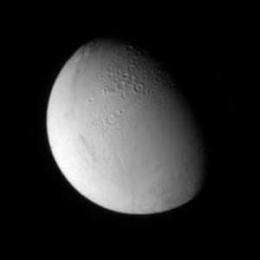Gravitational tide the secret of Saturn's weird moon

Enceladus, a white moon of Saturn with ice-spewing volcanoes, owes its strangeness to tides of gravitational forces exerted by its mother, a study in Nature said on Wednesday.
Discovered in 1789 by William Herschel, Enceladus measures only 504 kilometres (315 miles) across yet is one of the great oddities of the Solar System.
Its surface is a gorgeous white shell of ice, rather than asteroid-pocked rock and dust, and the surface is pristine except for a network of fractures near its south pole.
These cracks—dubbed "tiger stripes"—emit fountains of water vapour that instantly turn into icy grains on contact with the chill vacuum of space. Some astrophysicists conclude that the worldlet harbours an ocean of saltwater, which in turn makes it a good candidate as a source for life. But how can a sub-surface sea exist, if the ambient temperature is close to absolute zero—-273 degrees Celsius (-460 degrees Fahrenheit)—and the Sun is a distant dot?
The answer, say theorists, lies with a phenomenon called tidal forces. They argue that the gravitational pull exerted by Saturn, the second largest planet of the Solar System, squeezes Enceladus' innards, causing friction whose heat allows the water to remain in a liquid state.
Long debated, the notion has now gained the support of comparisons of the icy plume as the moon crawls around Saturn on an egg-shaped orbit.
When Enceladus is closest to Saturn, the plume is at its dimmest, a sign that the fractures are being closed up by a mighty gravitational pull from the giant mother plant, and so relatively little water escapes, according to the new study.
When Enceladus is at its farthest point from Saturn, the plume is several times brighter, suggesting that the fractures open out—rather like an unclenched fist—and more water is disgorged. The evidence comes from 252 infra-red images taken by the great US explorer probe Cassini during its lonely swings around the planet.
They provide "strong evidence that tidal forces do play an important role in controlling Enceladus' plume activity, perhaps by changing the width of the conduits between the surface and various underground reservoirs," says the paper, led by Matthew Hedman of Cornell University in New York. Many of the icy grains from Enceladus fall back on its surface, which explains its dazzling white surface.
The ice may also be the origin of one of the rings of Saturn that give the gas giant its special beauty, according to some thinking.
More information: Paper: dx.doi.org/10.1038/nature12371
Journal information: Nature
© 2013 AFP





















